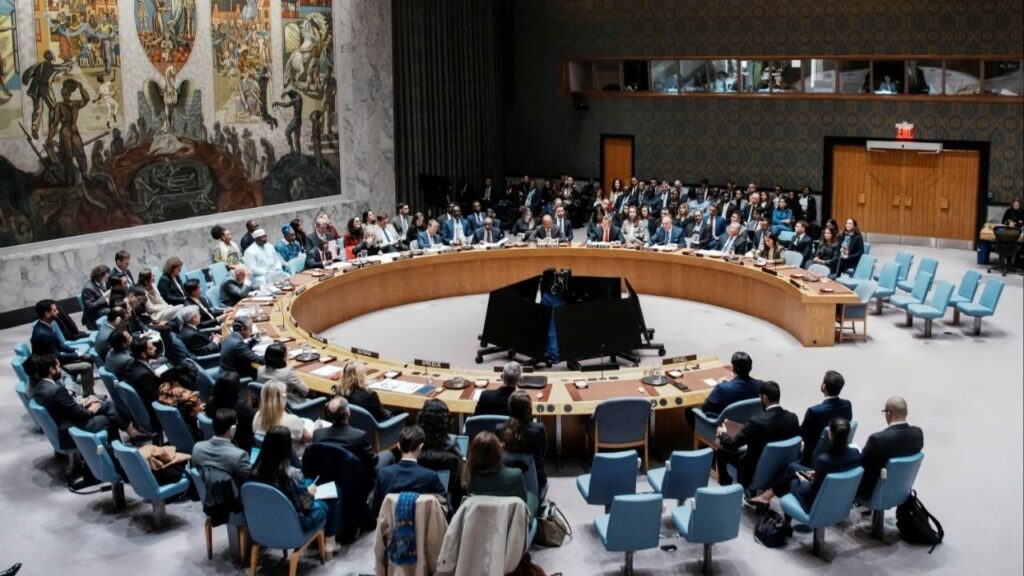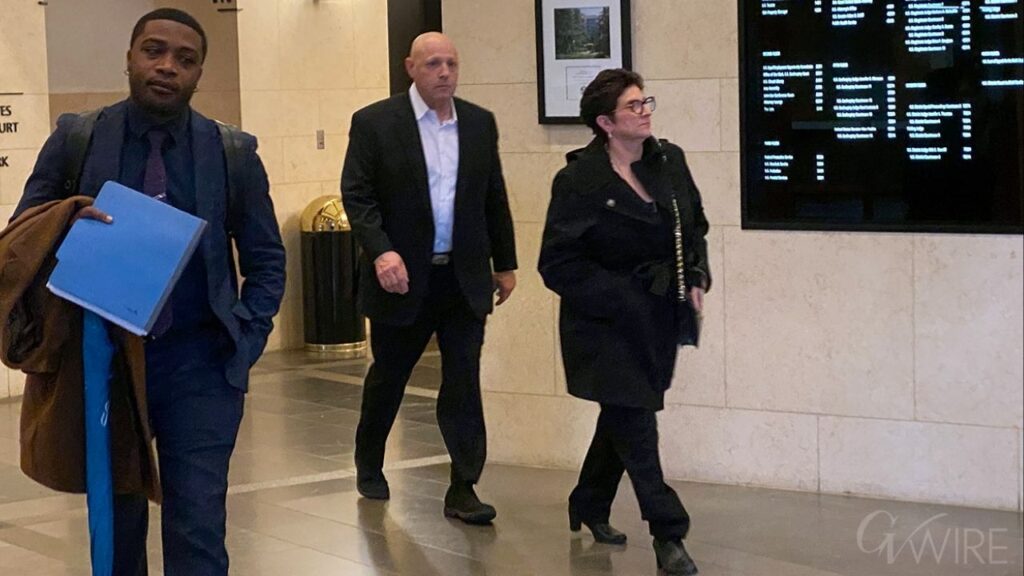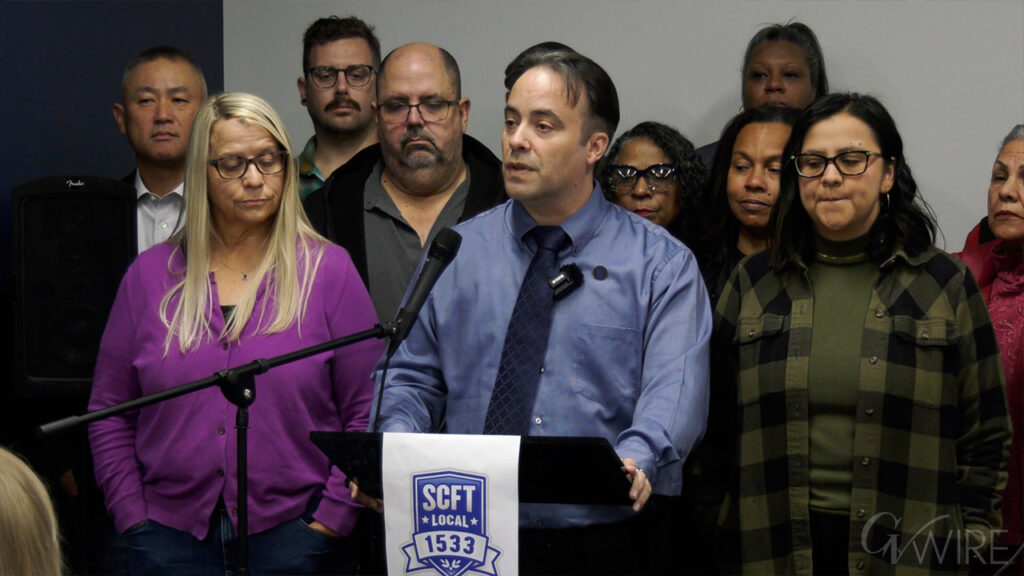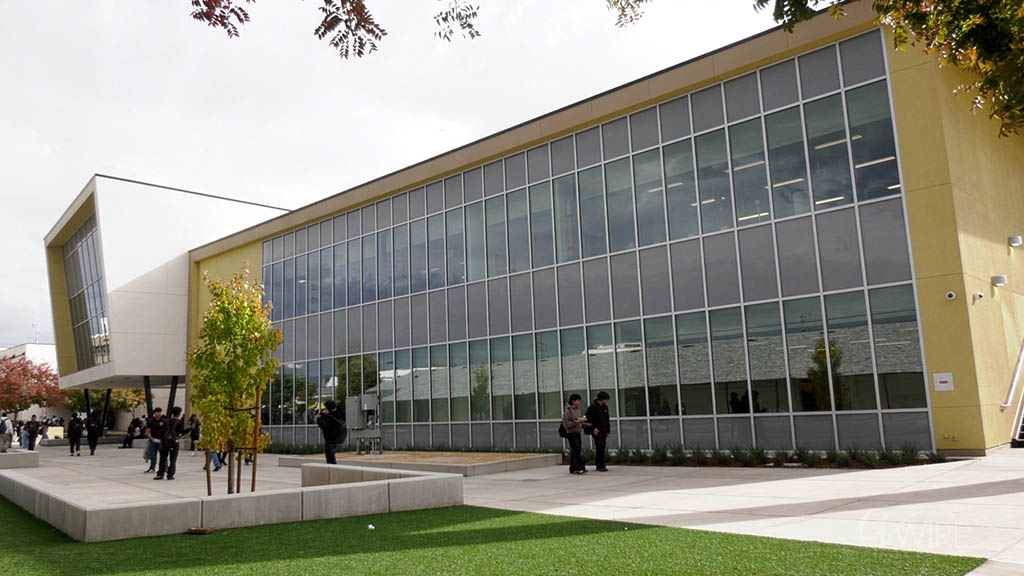Reports of immigration sweeps, both real and rumored, are creating a climate of fear and uncertainty for immigrant communities in California's agricultural heartland. (CalMatters/CatchLight Local/Larry Valenzuela)
Share
|
Getting your Trinity Audio player ready...
|
This story was originally published by CalMatters. Sign up for their newsletters.
Truth be told, there’s a lot of white trucks in Modesto.
White Dodge Rams, white GMC Sierras, white F150s, white Ford Transit vans, white Suburbans, white Silverados, white Chevy Colorados. So many white trucks, all of them American-made: a sure sign of danger to people who read about a January immigration raid 130 miles south and spent the next two months watching for signs of the next one.
Regardless of who’s inside, those big white trucks have become a symbol of federal immigration enforcement in the heart of California’s farm country.
“They usually show up in white trucks, that’s the first signal,” said Lorena Lara, director of organizing for the Valley Watch Network, a coalition of volunteer dispatchers and legal observers who respond to reports of immigration raids in the Central Valley. “Then we look for license plates, they’ll say DHS, or there won’t be a license plate. The trucks have big antennas, like huge, always American-made. Sometimes you can see a divider between the front and the back.
“You don’t know which truck will be immigration (enforcement). And our dispatchers will get calls, saying there are trucks in the area, even if it turns out to be construction workers or something. Families are too scared to pick up their kids (from school). They’re too scared to go grocery shopping.”
New Valley Watch volunteers learn to watch for white trucks and vans as part of their training. Those volunteers said the effect lingers: When they’re driving to the grocery store or parking at the movie theater, they can’t help but notice them. And for a moment, they’re afraid.
This is the stated intention of the Trump administration’s plan to deal with illegal immigration, part of what the president promises will be the largest deportation program in American history.
“If you are here illegally, we will find you and deport you,” said Homeland Security Director Kristi Noem earlier this month. “You will never return. But if you leave now, you may have an opportunity to return and enjoy our freedom and live the American Dream.”
While immigration enforcement agents continue to detain individual people outside of their homes or at the entrance to a Walmart, the deportation program’s larger hope is to encourage people here illegally to self-deport by creating enough fear and mistrust among immigrant communities in places like the Central Valley.
It remains to be seen whether the self-deportation plan is working.
As to whether it’s creating fear — that part is working just fine.

“It feels like you’re on edge all the time,” said Blanca Ojeda, a Valley Response Network volunteer dispatcher and a recipient of Deferred Action for Childhood Arrivals, a 2012 program that allows people who came to the country illegally as children to receive deportation deferrals every two years. “It’s constant.”
Attendance at Catholic masses is down in the Fresno Diocese, which includes most of the San Joaquin Valley. Callers to the Valley Response hotline have reported that agricultural workers aren’t going to the citrus fields. They’ve heard reports of parents keeping their kids home from school, a trend documented in attendance figures in similar California communities. The flea market in Fresno has emptied out.
The Catholic masses began shrinking after immigration raids in Bakersfield in January, said Diocese of Fresno spokesman Chandler Marquez, and the attendance drop has been especially pronounced “in parishes that fall within the rural areas of our diocese.”
A key factor in getting people to self-deport is making it easy – in this case with an app in which people can report that they’re leaving the country. But just as important is making people in the country illegally worry about what happens if they stay.
That’s where rumors come in. Most are spread naturally, through honest but wary people who mistake a parked white truck for an immigration enforcement vehicle. Sometimes, Ojeda said, volunteers show up to a report of a raid, only to find the rumors were prank calls.
The effect is the same: Fear has a firm grip on immigrant communities in the Central Valley. Ojeda said some families have refused to leave the house for fear of apprehension by immigration enforcement agents.
The Valley Response volunteers have been collecting their stories. One elementary school student complained in class in February that he didn’t have food at home. Upon investigation, Ojeda said, Valley Response volunteers found that the adults in the family hadn’t left the house since the January immigration raid in Kern County in January and were asking neighbors to pick up their kids from school.
“We got them connected with services, we brought them food boxes, but how many other kids are out there (who) didn’t speak up,” she said.
Ojeda said she gave a know-your-rights lecture at a Catholic church in Merced and noticed all the empty pews, even after a Sunday mass. She said the priest told her that his attendance is down 60%-70%, especially after the Trump administration issued an executive order allowing immigration raids at places that had protected status under the Biden administration, such as churches, schools and hospitals.

Reports have spread among the volunteers of Immigrations and Customs Enforcement impersonators putting blue and red lights on their cars and pulling people over, something that is happening across the country.
“We asked the (Stanislaus County) sheriff what we should do,” Ojeda said. “He told us that you have to pull over if you see (blue and red) lights, but call 911 immediately, if the person comes to your window, call (police) dispatch immediately and ask for their name, we’ll let you know whether yes, indeed it’s an officer, or not.”
The Stanislaus Sheriff’s Office did not return calls and emails from CalMatters. The sheriff has previously insisted in a video message that his office does not enforce federal immigration law. While California’s sanctuary state law dictates what police are allowed to do regarding undocumented people, the law doesn’t have any bearing on the actions of federal agents.
Fearful people have turned to the legal system for reassurance, but even that path is perilous. The California Attorney General’s Office warned that families have reported giving “immigration consultants” thousands of dollars, only to find that they never had legal standing to argue for staying in the country – or, worse, that the person who took their money wasn’t even referring their case to a lawyer.
She’s also noticing the quiet. Ojeda said she hasn’t heard much of anything from her representatives in Sacramento or Washington, D.C.
“I know our state legislators have said publicly some stuff, but it still feels like not enough,” Ojeda said.
That has left volunteer groups and faith-based organizations as the loudest protest in the Central Valley against the Trump administration’s deportation program, including Valley Watch, which was founded during the first Trump administration.
Usually their work involves educating people on their rights, but sometimes, the game of cat-and-mouse gets turned on its head. Last month, Ojeda and another volunteer spotted a white van on California State Route 99 and followed it north from Modesto to Stockton.
It had all the hallmarks of an immigration enforcement vehicle: a tall antenna, large men in the vehicle, some kind of divider separating the front seats from the back.
“I think they realized that we were recording them, so they started to go faster, and eventually we lost them, but we saw what exit they got off on,” Ojeda said.
It was the same exit as a Stockton Immigration and Customs Enforcement holding facility.
On the drive back to Modesto, Ojeda was still scanning the highway for white trucks.

White Lies to Mom
When Valley Watch Network director Lorena Lara lies to her mother, she tries to make the lies believable. Sure, it looks grim, she says, but it will get better quickly. They can’t keep targeting people, there’s not enough agents. And even if there were, this government doesn’t have a plan to get rid of all the estimated 11 million undocumented people in this country.
She doesn’t believe any of it. The situation is grim, it’s likely not going to get better for people here illegally. The Trump administration does indeed have a plan – it’s published on the White House website. It’s called “Protecting the American People Against Invasion.”
Lara’s mother is an undocumented immigrant who brought Lara to this country from Mexico. Lara lies to her because, she said, the truth would be worse.
“I tell her, well, things are OK right now,” she said from her office in Fresno. “I’m lying by omission.”
It’s a role reversal for Lara and her mother.
“I remember, growing up undocumented, after a certain point, my mom would say, you know, everything’s going to work out, it’ll be fine, this year something’s going to happen with our (immigration) status,” Lara said. “In 30-plus years, nothing has happened. Nothing is fine.
“And now we have this.”


She’s not telling her mother that reports of Immigrations and Customs Enforcement activity are piling up every day. A public website that collects tips about immigration raids publishes the alerts.
“Saw an officer wearing green outfit with a black vest that said ‘POLICE,’ “ read one alert.
“FBI and ICE were conducting raids in Madera. They seen them behind the Lowe’s. There are a lot of trucks,” read another.
“Black truck with tinted windows and Government plates 100% sure it was an undercover,” read a third.
In addition to the Central Valley, there are immigration response groups covering every county, from Los Angeles and the Inland Empire to the Bay Area and the far northern reaches of the state.
Along with answering the hotline phone, the groups are organizing meetings with public officials, holding know-your-rights seminars in immigrant-dominant communities and handing out small red cards that explain people’s rights in English and Spanish.
Their efforts to get a friendly ear with elected politicians — especially sheriffs — have been difficult. And even when they get a meeting, such as the one with the sheriff of Stanislaus County, the outcomes have been dissatisfying.
Law enforcement in the Central Valley seems divided on how to balance its need for cooperation from immigrant communities with the presence of immigration agents in their cities and counties — and staying within the bounds of California’s sanctuary state law.
In Amador County, a foothill community on the east side of the valley, the sheriff has proclaimed that he will deliberately violate the sanctuary law by contacting immigration authorities as soon as he has someone in custody whom he believes to be in the country illegally.
Farther south, at the Fresno Police Department, deputy chief Mark Salazar is working to reassure immigrants that they can safely share tips and communicate with officers.
“The police department tries to ensure it has cooperation from Spanish-only communities,” Salazar said. “DEA, (Homeland Security Investigations), all of them, they know we don’t mess with immigration. We don’t mess with Border Patrol, we’re not here to do raids. And so when your federal partners are doing things like that, then (the community) has to know, it’s not us.”
Salazar said the risk of violating that understanding is grave.
“We can’t break that, because if we break it, I think we’ll go back to having crimes not solved,” Salazar said. “We’ll go back to (the) community not trusting us.”
To Lara, dissolving that trust is part of the Trump administration plan.
“Oh, a thousand percent, a thousand percent that’s part of their goal,” Lara said.
Is it working?
“Yes.”
So she tells her mother things that aren’t exactly true, because it’s easier.
“It feels protective,” she said. “It feels like the right thing to do at the moment because I’m trying to maintain a fine line about, like, educating my mom and also having her not spiral and be in the depressive mode.”
In a small conference room in Fresno, she starts to cry.
“The thing between her and I is that it’s unspoken,” she said. “It’s like, Mom, things aren’t fine. They’re worse. What are you gonna do now? Do you wanna stay here, do you wanna go back? And that’s a question that I personally haven’t had the courage to ask her.”
A call comes in over the hotline.
“Hi, this is Elizabeth, I have not heard anything from my husband,” said the voice on the phone. “I’m really worried about the fact that it’s already another day. The lawyer didn’t call me back, is there anything I can do? Like, just anything that can give me just a little bit of hope?”

Inside The ICE Detention Center
Elizabeth Chavez sits at a four-seat table in the Golden State Annex, an immigration detention facility outside Bakersfield. Seated to her right is her husband, Alfredo Naranjo, 31, wearing a red jumpsuit. Their three children are in their van in the parking lot, waiting with Chavez’s parents.
“We tell the kids he’s working,” Chavez said.
The eldest child is 5. Chavez worries that he’s starting to catch on to their ruse.
Behind the fear in the Central Valley, behind the smaller classes and empty church pews, is the reality of immigration detention. Along with the alarms, false and real, about white trucks idling behind a grocery store, there are the people sitting in places like this, waiting to learn their fates.
At the detention center’s chain-link courtyard entrance on a chilly weekend morning in March, a dozen people mill around under loops of razor wire, waiting to be buzzed in by the Geo Group private prison company employee who runs the front door.
Each door in this facility is remotely operated by unseen guards. Families walk through the metal detector and follow a guard’s directions to the meeting area. Every 20 feet is another hallway, another door, another buzzer.
A final turn and the detention center’s day room comes into view, about 20 tables spread out over a space about the size of a large public high school cafeteria. At each table is a person in an orange or red jumpsuit, sitting in tiny clumps with the people who came to see them.
Chavez has dyed her hair a dark shade of purple. She is chatty, vivacious and afraid. Her husband is quiet. Together, they try to explain how he woke up on a Tuesday morning ready to take Chavez to a hospital visit and instead arrived here.
It all started with the cat.
As they walked out of their house in Patterson, Chavez saw a white minivan parked outside of their house. Her husband saw a small, white cat on the ground, putting its paws on the passenger side’s doors.
“He’s like, look, the cat is trying to get inside the van, and I was like yeah that’s funny,” said Chavez, 25. “It never crossed our heads that there was people in there.”
They sat down in their car. Then they saw the minivan’s driver activate red and blue lights, no siren.
“All of a sudden someone is knocking on the window, like banging on the window, hard,” Chavez said. “Then they said (Naranjo’s) name, which threw us off so much, it didn’t cross our minds that it was ICE.”

Naranjo stepped out of the car. Chavez said the agents started yelling, then put handcuffs on him. Chavez asked the agents for a warrant, and was told they didn’t need one.
The agents told Chavez that Mexico was “asking for” Naranjo. She asked the agent what Naranjo was accused of doing and the agent told her to ask her husband. Naranjo denied knowing what they were talking about.
The agents knew Chavez’s name. Even though she has legal status in this country, she was immediately terrified that they were about to take her, too.
Friends directed her to the Valley Response hotline, which connected her with an immigration attorney. So far, the government of Mexico has not provided any documentation indicating that it asked for Naranjo’s detention.
“We don’t know specifically why ICE may have been targeting him,” said attorney Katie Kavanagh of the California Collaborative for Immigrant Justice. “It’s in line with what we’ve been seeing in enforcement actions throughout northern (and) Central California. We are seeing a lot of folks, even with little or no history of criminal arrests, being targeted simply because they have an immigration history.”
Naranjo said he has crossed the border only once, in 2016, and has no other criminal charges against him, but did once get a speeding ticket. CalMatters was unable to find a criminal history for him in Mexico or determine if one exists.
“When he was talking to the kids, he broke down,” Chavez said about Naranjo’s first call after he was detained. “The kids were asking him, like, when are you coming back? How are you doing your homework? Aren’t you coming home?”
The eldest child started to cry, she said, and her middle daughter was starting to sniffle when she decided to lie. For now, the kids still believe he’s at work.
Now, Chavez worries Naranjo’s not eating. Sometimes, he told her, the meal times get pushed back by several hours, and if you miss it, you’ll stay hungry until the next one. But mostly, he tries to assure her that he’s fine and all of this will seem like a bad dream.
“Of course he’s gonna say everything’s OK, because he doesn’t want me to worry about it,” Chavez said. “But I just don’t really know if he’s OK.”
Kavanagh, the attorney who helped with the immediate response, is unable to take on their case. For now, they’re on their own.
So Chavez makes these weekly pilgrimages down to Bakersfield, a three-hour drive each way. Out in the parking lot, the kids don’t know their father is just a few hundred feet away.
Past the parking lot is State Route 99, the main north-south artery connecting the Central Valley, where Valley Response volunteers sometimes chase white trucks.
Further east, just visible on a clear day, is the Sierra Nevada mountain range, blue and snow capped and still, and beyond that an apartment complex in Denver and a a federal courthouse in Chicago and a car wash in Philadelphia where the largest deportation program in American history is just getting started.
This article was originally published on CalMatters and was republished under the Creative Commons Attribution-NonCommercial-NoDerivatives license.
RELATED TOPICS:
Categories

Hamas Rejects UN Gaza Resolution

Kaweah Health Names New CEO. He is Marc Mertz


















